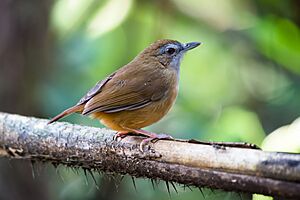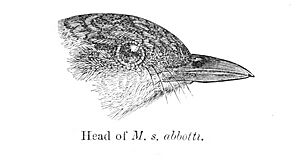Abbott's babbler facts for kids
Quick facts for kids Abbott's babbler |
|
|---|---|
 |
|
| Khao Yai National Park, Thailand | |
 |
|
| Conservation status | |
| Scientific classification | |
| Genus: |
Malacocincla
|
| Species: |
abbotti
|
| Synonyms | |
|
|
The Abbott's babbler (Malacocincla abbotti) is a small bird that lives in forests. It belongs to the Pellorneidae bird family. You can find these birds across the Himalayas in South Asia and in the forests of Southeast Asia. They are short-tailed and a bit plump. These birds usually search for food in pairs. They like to stay in thick bushes close to the ground. You can often tell they are nearby because of their special calls.
Contents
Understanding Abbott's Babbler: How Scientists Name Them
Scientists use a system called taxonomy to name and group all living things. This helps us understand how different species are related. The Abbott's babbler was first described by an English zoologist named Edward Blyth in 1845. He gave it the scientific name Malacocincla abbotti.
The name Malacocincla comes from old Greek and Latin words. Malakos means "soft," and cinclus means "thrush." This refers to the bird's soft, fluffy feathers. The second part of the name, abbotti, honors Lieutenant Colonel J. R. Abbott. He was a collector who helped Blyth find this bird.
Scientists sometimes change their minds about how to group birds as they learn more. For a while, the Abbott's babbler was placed in different groups. But in 1985, it was put back into the Malacocincla group.
There are several types of Abbott's babblers, called subspecies. These are like different versions of the same bird that live in various places. Here are the eight recognized subspecies:
- M. a. abbotti – Found from the eastern Himalayas to the central Malay Peninsula.
- M. a. krishnarajui – Lives in eastern India.
- M. a. williamsoni – Found from eastern Thailand to southern Vietnam.
- M. a. obscurior – Lives in eastern Thailand and southwest Cambodia.
- M. a. altera – Found in central Laos and central Vietnam.
- M. a. olivacea – Lives in the southern Malay Peninsula and Sumatra.
- M. a. concreta – Found on Borneo and Belitung Island.
- M. a. baweana – Lives on Bawean Island, which is north of Java.
What Does Abbott's Babbler Look Like?
The Abbott's babbler is a brownish bird with a short tail. It often moves around in low plants, especially near streams. You might see it close to tree ferns and tangled bushes.
Its throat is gray-white, and the middle of its belly is white. Its sides are olive-colored, and the feathers under its tail are a rusty color. Both male and female birds look alike. They have a short tail and a strong, thick beak. Their body is a dull olive-brown. They have bright rusty lower sides and a grayish-white throat and chest. They also have a pale gray stripe above their eyes. Young birds have darker, reddish-brown heads and upper bodies.
The subspecies M. a. krishnarajui, found in the Eastern Ghats of India, has a darker reddish-brown tail and rump. These birds are usually about 12 to 13 centimeters (about 5 inches) long. Their head is about 3.9 to 4.4 centimeters long, and their tail is about 5.5 to 6.1 centimeters long.
Where Do Abbott's Babblers Live?
In South Asia, the Abbott's babbler lives in places like Nepal, Arunachal Pradesh, and the Assam Valley in India. It also lives in the hills of South Assam, including Meghalaya, and south through the Lushai Hills. You can also find it in eastern and southern Bangladesh and in the Eastern Ghats of northeast Andhra Pradesh and Odisha.
These birds usually live in areas up to about 600 meters (about 2,000 feet) high. In Nepal, they are found up to about 275 meters (about 900 feet) high. They are also found widely across Southeast Asia.
Abbott's babblers are quite common in most of the places they live. They prefer the lower parts of broadleaf evergreen forests, forest edges, and areas where new plants are growing. In Singapore, these birds have shown they can adapt well to areas where the forest has been disturbed or is growing back.
How Do Abbott's Babblers Live?
Abbott's babblers usually move around in pairs, staying close to the ground. They build their nests from April to July, which is during the summer monsoon season. Their nest is a carefully made cup, but it can look a bit messy. They build it low in palm trees or other thick plants. A study in Thailand found that most nests are built in spiny palms and rattan plants.
A female Abbott's babbler usually lays 3 to 5 eggs. These eggs are a bright salmon color with dark spots and red lines. If a bird is disturbed while on its nest, it will quietly slip off. Then it flies away with slow wing beats and hops out of sight. They might raise more than one group of young birds in a single season.
These birds have very unique calls. Their calls often have three or four notes, with the middle note dropping lower. Sometimes, a male and female will sing a duet together. The male might start with a sound like "poor'ol bear," and the female will follow with "dear dear." However, their songs can change over time. These birds tend to stay in their own area and do not travel far.
Their song is a short series of about three to four notes. These notes are rich, clear, and sound like a flute. They can be sung slowly or quickly. When a group sings together in the evening, they make a sputtering "churrr" sound. This sound is low and slurred, ending with a sharp "chreep." They also make soft "mewing" sounds and a purring trill when they are upset.




